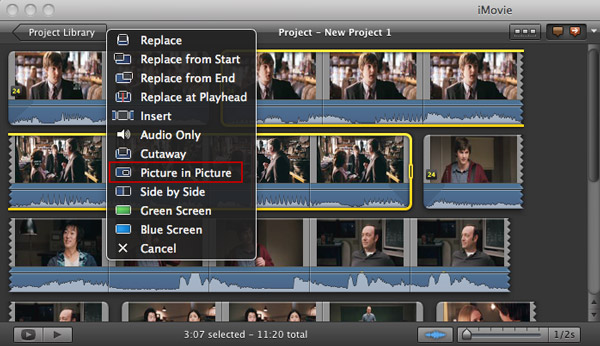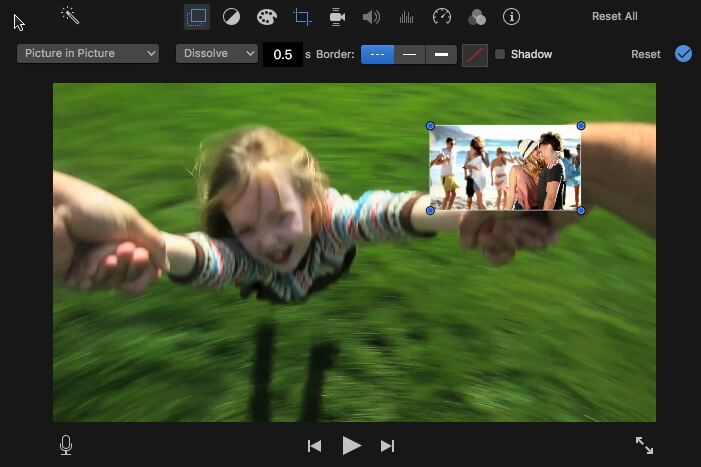
To resize the top video, click on one of the blue dots, which are called handles, in the corners of the window, as highlighted by the red arrow in the screenshot below.Īs you drag one of these handles towards the center of the image, the window will shrink, and as you drag it away from the center, the window will grow.

To move the top window, just click anywhere inside it (in the Viewer window), hold, and drag it to where you want it. Moving and Resizing Your Top Pictureīecause iMovie just sort of plops your top video onto the bottom video, and in a default size, you will want to move it to a place you are happier with, and probably adjust its size. Just to the right of these options is the box to set the color of the border’s line.įinally, if you check the gray square next to the Shadow option, your picture in picture will cast a small shadow, which gives the whole thing a more three-dimensional effect, like the top picture is floating above the bottom video. The three buttons to the right of the Border label allow you to choose between having no border (the dashed line icon), a line border, or a thick line border. The next group of settings provide control over the Border of your top video’s window. This sets the time it takes for the Transition you chose to happen and is measured in seconds. The next setting in the Video Overlay Settings is the number field, which is currently set to 0.5 in the screenshot above.
Picture in picture imovie full#
The last Transition option, the Swap Transition is pretty much the opposite of the zoom transition – your top clip starts as the full screen and shrinks to its window size when the picture in picture effect starts, and vice versa when the effect ends.

It is the most passive and natural feeling transition among the options, so is usually a safe choice.īut you can also have your top video zoom in and out, which means it starts as a dot and quickly zooms in to the size of your top video’s window and shrinks back to a dot when your clips near its end. It is a kind of Fade Transition where the details of your picture sort of sprinkle in and sprinkle out. The Dissolve Transition is the default one for good reason. The first option, to the left of the dropdown menu where you selected Picture in Picture, and which is currently set to “Dissolve”, allows you to customize the top video’s Transition onto (and off of) the bottom video. It is unlikely that where iMovie placed your top video is exactly where you want it, or you want to adjust the size of the window, so below I will take you through all the various settings and adjustments iMovie provides to customize your picture in picture effect.įirst, let’s take a closer look at the Video Overlay Settings, shown again in the red oval in the screenshot below.
Picture in picture imovie how to#
You have created a picture in picture effect! How to Change the Settings of Your Picture in Picture Effect In the screenshot above, my top video of somebody typing is now in a small window between the two men talking (where the yellow arrow is pointing).Īnd that, my friends, is all there is to it. Now that this row of settings is visible, select Picture in Picture from the dropdown menu on the far left, highlighted by the green arrow in the screenshot above.Īs soon as you’ve selected Picture in Picture, your top video will appear as a smaller window on top of your bottom video (or, if you prefer, in the foreground). This row, highlighted by the red oval in the screenshot below, only appears when a clip is selected that is on top of another clip – because that is how iMovie knows you will need the overlay settings.īut if the Video Overlay Controls aren’t visible, for whatever reason, you can always click the Video Overlay Settings button, highlighted by the red arrow in the screenshot below, to make them appear. Now, making sure your top clip is highlighted (it has a yellow border around it, like in the screenshot above), you should see a row of Video Overlay Settings in iMovie’s Viewer (which is in the top right corner of the iMovie window) This signifies the exact spot where the top clip is attached to the bottom clip and is thus where your picture in picture effect will start. Note the blue line, which is called a stem, highlighted by the red arrow in the screenshot below. In the screenshot below, I have dragged a short clip of somebody typing, and placed it on top of a clip of two people talking. To add one video on top of another, first select the clip you want to appear on top of another, and then drag it – literally – on top of the other clip. How to Add a Picture in Picture Effect in iMovie How to Change the Settings of Your Picture in Picture Effect.


How to Add a Picture in Picture Effect in iMovie.


 0 kommentar(er)
0 kommentar(er)
